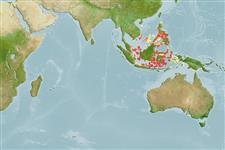>
Ophidiiformes (Cusk eels) >
Dinematichthyidae (Viviparous brotula)
Etymology: Ungusurculus: Name from Latin words 'ungulus' (= claw) and 'surculus' (= grapevine tendril), refers to the functional analogy with the pseudoclaspers and the specific shape of the inner pseudoclasper.; philippinensis: Named for the Philippine Islands, its area of distribution..
More on authors: Schwarzhans & Møller.
Environment: milieu / climate zone / depth range / distribution range
экология
морской ассоциированный с рифами; пределы глубины 5 - 10 m (Ref. 90102). Tropical
Western Pacific: Philippines.
Size / Вес / Возраст
Maturity: Lm ? range ? - ? cm
Max length : 4.8 cm SL самец/пол неопределен; (Ref. 76869); 5.2 cm SL (female)
Краткое описание
определительные ключи | морфология | морфометрия
членистые (мягкие) лучи спинного плавника (общее число) : 78 - 87; членистые (мягкие) лучи анального плавника: 54 - 66; позвонки: 42 - 44. This species is distinct with the following characters: D 78-87, A 54-66, D/A 22-27, V in D 2.2-2.4; vertebrae 12-13+29-32=42-44; anterior nostril located 1/4 the distance from upper lip to aggregate distance to anterior margin of eye; free pseudoclaspers 2 pairs, outer pseudoclasper wing-shaped with broad base and distally slightly widened supporter without anterior hook, the inner one moderately long, with widened base, distally with 2 inward directed strong spines; cheeks with 5-6 scale rows on upper part and 3-4 rows on lower; no upper preopercular pore; otolith moderately elongate, its length to height is 2.0-2.1, pointed anterior and posterior tips, short sulcus with ventral indentation at joining of ostium and cauda, partly fused colliculi, its centre anterior to centre of otolith, inclined about 10°, otolith length to sulcus length is 2.0-2.1 (Ref. 76869).
Inhabitant of reef crevices, cryptic and solitary (Ref 90102).
Life cycle and mating behavior
Maturities | размножение | Spawnings | Egg(s) | Fecundities | личинки
Schwarzhans, W. and P.R. Møller, 2007. Review of the Dinematichthyini (Teleostei: Bythitidae) of the Indo-west Pacific. Part III. Beaglichthys, Brosmolus, Monothrix and eight new genera with description of 20 new species. The Beagle, Records of the Museums and Art Galleries of the Northern Territory 23:29-110. (Ref. 76869)
Статус Красного Списка МСОП (Ref. 130435)
Использование человеком
рыболовство: интереса не представляет
дополнительная информация
инструменты
Специальные отчеты
Скачать в формате XML
ресурсы в Интернет
Estimates based on models
Preferred temperature (Ref.
123201): 28.1 - 29.2, mean 28.8 °C (based on 560 cells).
Phylogenetic diversity index (Ref.
82804): PD
50 = 0.5156 [Uniqueness, from 0.5 = low to 2.0 = high].
Bayesian length-weight: a=0.00389 (0.00180 - 0.00842), b=3.12 (2.94 - 3.30), in cm total length, based on all LWR estimates for this body shape (Ref.
93245).
Trophic level (Ref.
69278): 3.2 ±0.5 se; based on size and trophs of closest relatives
Fishing Vulnerability (Ref.
59153): Low vulnerability (10 of 100).
